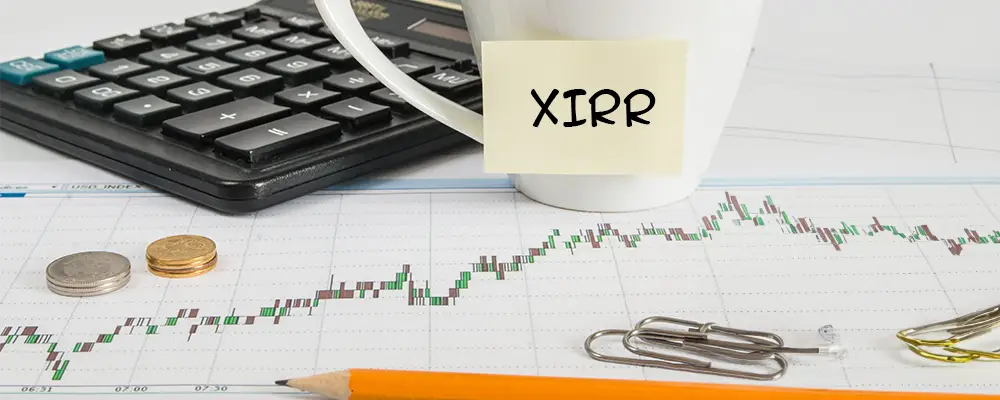Understanding XIRR: A key metric for mutual fund performance
Posted On Tuesday, Aug 06, 2024
Introduction
When selecting a mutual fund scheme, what comes to your mind? Is it returns?
Investing in mutual funds is a compelling avenue for long-term wealth creation, but assessing their performances can be complex. Two metrics are generally used to calculate mutual fund performance:
- XIRR or extended internal rate of return and
- CAGR or compound annual growth rate.
For calculating returns for lumpsum investments, CAGR is used. However, for SIPs (systematic investment plans), where timing and cash flows matter, XIRR is considered a better option.
So, what is XIRR? In this article, we will explore the concept of XIRR, its calculation and its importance.
What is XIRR in mutual funds?
When investing in mutual funds, you must understand the XIRR meaning in mutual fund returns. As many investors ask, “What is XIRR return?”.
XIRR essentially refers to a measure used to evaluate the performance of a mutual fund scheme. XIRR full form is an extended internal rate of return.
In simplest terms, XIRR means a financial metric that computes the annual returns on investment, considering both the invested amount and also mid-way cash flows and their timing.
The CAGR, for example, only looks at the beginning value and the final value of the investment, whereas XIRR includes all inflows and outflows over time and when they happened (even if cash flows are irregular).
Therefore, it is a better way to measure SIP’s performance because you can consider each SIP instalment, including the amount, dates, and withdrawals.
Also, since XIRR considers the compounding effect and time value of money when computing mutual funds’ returns, it becomes a more prudent financial metric.
Why is XIRR important for mutual funds?
Mutual funds need the XIRR as it provides a better understanding of your investment returns, particularly if you have irregular cash flows. Here is how it helps:
Precise assessment: CAGR assumes that investments are made at consistent intervals. But XIRR considers all the inflows and outflows in between, like dividends, redemptions and withdrawals, to provide a more accurate estimate. Further, it also considers the timing and magnitude of cash flows.
SIP friendly: SIPs are widely used by many investors to invest in mutual funds. To calculate returns for SIPs, consider using XIRR, since this method takes into account all the SIPs done during the investment period.
Redemption processing: When you redeem some of your units, it has an impact on your overall returns. By incorporating these withdrawals into its calculations, XIRR ensures that there is high precision regarding the performance of your investment.
Comparative instrument: XIRR can help you evaluate the performances of various mutual fund investments effectively, no matter if you invested in them at different times and with varying amounts. This helps assess which funds are performing better for you.
How to calculate XIRR?
Calculating XIRR for your mutual fund is simple; you can use Excel.
In Excel, the XIRR function can be used to calculate the returns.
The function is: XIRR = (values, dates, [guess])
Here,
Values: This represents the total amount you have invested, including any redemptions. All the cash outflows (SIP instalments) should be recorded as a negative value, and cash inflows (redemptions, withdrawals) should be positive.
Dates: These are the dates of your investments.
Guess: You can leave this part blank.
XIRR - Calculation using Excel
Let us take an example to understand how to calculate the XIRR using the Excel function.
Suppose you invest ₹5,000 in an equity mutual fund scheme through SIP for one year, starting from 1 Jan 2023. After a year (say 15 Dec 2023), the redemption amount is ₹65,000.
Let us find the XIRR.
Step 1: Enter the SIP investment amount in one column.
Step 2: Enter the corresponding date in another column.
Step 3: Input the redemption amount in the last row along with the date.
Step 4: Use the Excel formula - XIRR = (values, dates, [guess])
| SIP Date | SIP Amount (₹) |
|---|---|
| 1 January 2023 | -5,000 |
| 1 February 2023 | -5,000 |
| 2 March 2023 | -5,000 |
| 3 April 2023 | -5,000 |
| 1 May 2023 | -5,000 |
| 1 June 2023 | -5,000 |
| 2 July 2023 | -5,000 |
| 1 August 2023 | -5,000 |
| 2 September 2023 | -5,000 |
| 1 October 2023 | -5,000 |
| 3 November 2023 | -5,000 |
| 1 December 2023 | -5,000 |
| 15 December 2023 | 65,000 |
| XIRR | 17.28% |
Source: XIRR Calculation - This is for illustration purpose only.
Here, 17.28% means that your investment has grown by an average of 17.28% in the year, considering when you deposited and withdrew money (cash flows and timings).
The XIRR takes into account the irregular cash flows invested during the year and gives a single percentage to represent how it has performed on the whole.
Final thoughts
XIRR is an essential metric for evaluating mutual fund investments, especially when regular contributions or withdrawals are made at different intervals, such as SIP.
Instead of looking only at the initial and final amounts invested in capital value terms, it tracks the timing and amount of each transaction, thereby making a reasonable estimate for returns. This aspect makes XIRR useful because it can be used to compare different mutual fund returns.
By understanding XIRR meaning, you can make informed decisions regarding your mutual fund portfolio and track progress towards long term financial goals.
Disclaimer, Statutory Details & Risk Factors:The views expressed here in this Article / Video are for general information and reading purpose only and do not constitute any guidelines and recommendations on any course of action to be followed by the reader. Quantum AMC / Quantum Mutual Fund is not guaranteeing / offering / communicating any indicative yield on investments made in the scheme(s). The views are not meant to serve as a professional guide / investment advice / intended to be an offer or solicitation for the purchase or sale of any financial product or instrument or mutual fund units for the reader. The Article / Video has been prepared on the basis of publicly available information, internally developed data and other sources believed to be reliable. Whilst no action has been solicited based upon the information provided herein, due care has been taken to ensure that the facts are accurate and views given are fair and reasonable as on date. Readers of the Article / Video should rely on information/data arising out of their own investigations and advised to seek independent professional advice and arrive at an informed decision before making any investments. None of the Quantum Advisors, Quantum AMC, Quantum Trustee or Quantum Mutual Fund, their Affiliates or Representative shall be liable for any direct, indirect, special, incidental, consequential, punitive or exemplary losses or damages including lost profits arising in any way on account of any action taken basis the data / information / views provided in the Article / video. Mutual Fund investments are subject to market risks, read all scheme related documents carefully. |
Related Posts
-

Understanding AMC: The Asset Management Company to Mutual Funds
Posted On Friday, Sep 06, 2024
In the world of mutual funds, the term "AMC" might appear frequently. AMC stands for Asset Management Company, and it manages the operation and management of mutual funds.
Read More -

IDCW Option in Mutual Funds: A Simple Guide for Investors
Posted On Thursday, Aug 29, 2024
The Indian mutual fund industry has grown incredibly fast over the past 10 years.
Read More -

How to Calculate Returns From an ELSS And Its Tax Implications
Posted On Friday, Feb 10, 2023
As you may know, there are multiple tax-saving options in India to save taxes under Section 80C of the Income Tax Act
Read More




